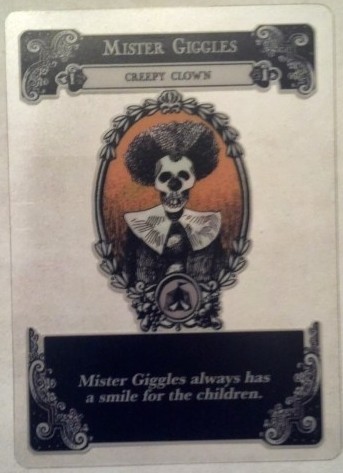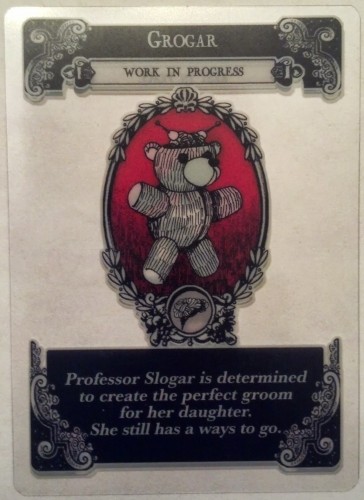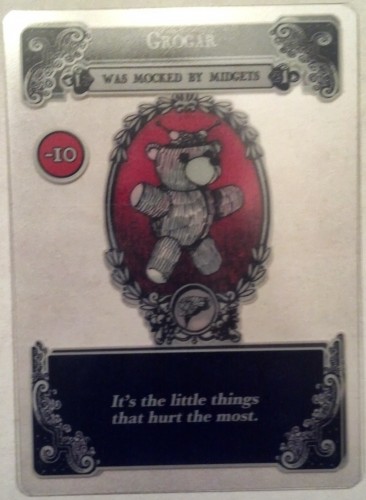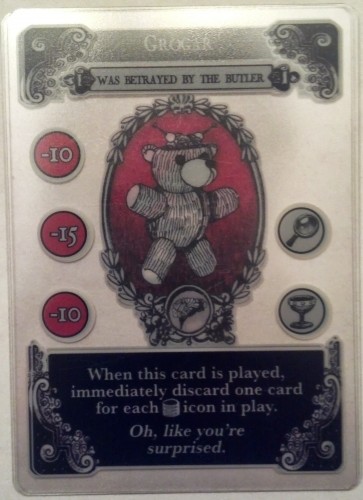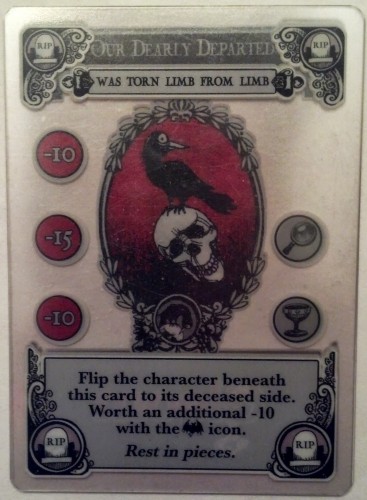Editor’s Note: We had a nice, moving soliloquy planned to accompany this piece, done by Lord Wellington-Smythe. We heard an early draft, and it was truly sorrowful and full of beautiful prose. Unfortunately, it seems that Lord Smythe has met an unfortunate end before finishing. It appears he was devoured by weasels after being jinxed by gypsies. A pity. It really was quite good...
The Premise
Players portray one of four families who are so beset with the rigors of their dreadful lives that their only respite is an unfortunate end. Players hamper their own families with a series of upsetting mishaps, making their characters as miserable as possible before shuffling them off to their timely demise.
The Rules:
Gloom may not be light in its macabre setting, but it is light in terms of setup and gameplay. As it is a card game, there is little effort needed to get started. First, each player is given one of four color-coded families. Each family comes with five Characters, placed face-up in no particular order. The remaining cards are then shuffled, and each player receives a starting hand of five cards.
A player’s hand consists of up to three different card types: Modifiers, Events, and Untimely Deaths. Modifiers are story cards that depict what misfortunes befall family members. They are placed on any player’s Characters. Modifier cards consist of up to three different sets of numbers on the left-hand side, called Pathos Points. These Pathos Points determine a character’s value, called Self-Worth. The more negative value, the better.
Additionally, most Modifier cards contain special effects that affect whoever the owner of the affected Character is, and they may also have a Story Icon on the right-hand side that can bestow bonus points at the end of the game. The cards in Gloom are transparent, and Modifier cards stack on one another. Whichever effects, Pathos Points, and Icons are currently visible will be the only ones active.
Untimely Death cards just that: these are cards that cause a Character’s demise, so long as their Self-Worth is below zero. A dead Character’s portrait is flipped over, and they can no longer be affected by cards. Because they’re dead.
Event Cards are single-use cards that provide special actions that happen when they are played. Unlike Modifiers or Untimely Deaths, however, they are discarded after use rather than played on a Character. Moreover, Event cards with the word “Cancel” are the only cards playable on another player’s turn.
In fitting with the game’s theme, players then decide amongst themselves who has had the worst day; that player goes first. Turns are taken three simple actions. The first two actions are nearly identical: a player chooses to either play a card, discard a card, or pass. The only exception is that the second card played cannot be an Untimely Death. Lastly, if a player’s hand is below five cards, they draw back up to five unless otherwise noted. It is then the next player’s turn.
Turns continue until one player’s entirely family is deceased. At that point, the game ends. Players count up the Pathos value of their dead Characters, and the person with the highest negative amount is the winner. The losers, it appears, are cursed with continuing their existence.
Bringing Some Darkness To Light
Gloom is, essentially, what would happen if the Addams family was full of the depressed and malcontent. There are very few genuinely redeemable Characters within the game. Rather, most of the people portrayed are nihilistic, incompetent sociopaths. Their world is a truly dreary place, and there’s no chance of it getting any better. Gloom wants you to pile misfortune on to your family, and then kill them off.
So, what’s stopping you? Jump right in and meet Goody Zarr, the Nefarious Nanny, or Willem Stark, the Disturbing Handyman. Then see about getting them to die, because they just aren’t good people.
That is done through the layer system the game has. Truly, one of the things that makes the game particularly unique are the cards themselves. In Gloom, the cards are transparent. Rather than attempt moving parts or pieces to deal with to depict the maladies affecting your characters, the game was instead designed by letting the cards pile on top of one another. As the game progresses, cards are placed on top of one another, in the hopes of generating the Pathos numbers you desire so that you can kill your character off. Letting the cards behave this way made the game simple since you don’t need extra components, and it also let the game stand out as something just a little bit different in the market.
At least in terms of mechanics.
We’re pretty sure that it’s already different enough with the whole “murder your family” thing it has going on.
The other thing of note is how much the game lives or dies by its theme. So much of Gloom’s entertainment is dependent on the card (and player) involvement. Indeed, aside from the Character portraits, there is little artwork to accompany card Modifiers and deaths. Instead it relies on flavor text and players’ collective imaginations. This can be seen as positive or negative depending on the player group, but generally letting the cards speak for themselves is fitting enough here.
To that end, we recommend reading the flavor text to the cards aloud in addition to playing them. It helps broaden the experience and makes the game’s ghastly setting that much more amusing.
A True Series of Unfortunate Events
Gloom, like many of Atlas Games’s works, is based around a semi-narrative gameplay. That is, a large selling point to the game is the in-game flavor as it is played out. Gloom certainly has flavor. Granted, it’s a very gothic-tinged dark humor, but it is prevalent throughout the entire game. What’s more, just like any good Coen brother’s flick, the true enjoyment in Gloom is from seeing how the story unfolds around those poor souls involved. Gloom really makes its mark with outcomes such as, “Cousin Mordecai was Cursed by the Queen, Was Driven to Drink, and then Was Torn Limb From Limb…”
Poor Mordecai…
Unsurprisingly, then, the one group that will certainly appreciate this game are the Immersionists. Just like a good tabletop, there’s a story to be told here, and you’re never quite sure exactly what’s going to happen from turn to turn. Does your family member get Blessed by the Bishop, or do they get Plagued By the Pox? And just why were they Pushed Down The Stairs?
In Gloom, understanding and appreciating the theme of the game is paramount to its enjoyment. Immersionists should enjoy Gloom, so long as they don’t mind things with a bit of a dark comedic tone. Daredevils too. How would a Brain in a Box get Sickened by Salmon? Leave it to a Daredevil to find out. These bizarre interactions will gratify them, even if the actual game itself doesn’t invite actual random behavior.
However, while the grim world setting may bring some to the table, it alone won’t hold the attention of everyone. Gloom bears all the markings of a filler card game, even if it does take about an hour with four players, putting it on the longer side of a filler game. As is the case with filler card games, Architects aren’t likely to gravitate towards this dreary landscape.
Likewise, fillers tend to be light on complexity and deep interaction, which is usually a cautionary tale for Tacticians. Gloom is no different. The turns are about as basic as you can get, and the focus is mostly about loading up your Characters with negative values in order to kill them. There is some maneuvering to be done at times, such as killing another player’s Character to prevent them from getting more points later, but the game’s depth is in its morbidity more than its mechanics. Tacticians looking for a lighter mental approach can enjoy the game, but it’s unlikely to be one that will enthrall them.
By contrast, the game is bereft enough to entice most Socializers. Interacting with one another’s family members through Modifiers and Untimely Deaths should be a good time – especially if they have a twisted sense of humor.
Similarly, Strikers will want to interact with your families in order to secure a victory. To them, the humor will be more of a bonus than part of the primary appeal. It’s a card game, so your stratagems towards winning are at the whims of Lady Luck (who does not appear in this game), and it can be a little swingy if you can’t draw the card type you need to stay in the lead. If this happens, it can temper their enthusiasm for the game some, but it’s never so random that you feel as if you have no control. Still, it is designed to be a rather simple game, and a good Striker knows someone has to win. Normally it’s victory or death. Here in Gloom, it’s both!
The Takeaway
Gloom bears its namesake well – this is not a game that invokes warm and fuzzy feelings. Instead, Gloom embraces its twisted world vision and invites the players along for the ride. The game is easy to learn, is relatively quick, and it fully invests itself into being as delightfully dark as it can while still being funny. The card combinations unfold to tell little snippet stories of the family members in seemingly never-ending ways, and if you are willing to follow the game down its dark and spooky rabbit hole, you’ll generally be amused with the results.
Liking the game’s themes are central its success, however. That fact can dissuade people looking for a game with some heft or those who prefer not to spend an hour offing their family members. Still, the game’s card-layering system and facetious humor are otherwise bearing a look at, and as far as filler games go, Gloom has some heart. Granted, that heart may be in a jar carried around by one of your family members, but it’s heart all the same.
Cardboard Republic Snapshot Scoring (Based on scale of 5):
Artwork: 3.5
Rules Clarity: 5
Replay Value: 3.5
Physical Quality 3.5
Overall Score: 3.5

